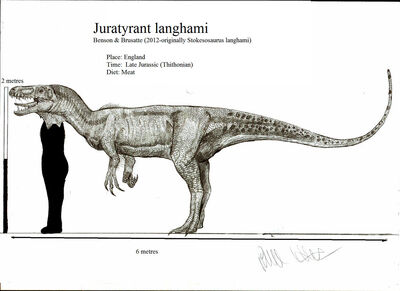Juratyrant is a Primitive Tyrannosauroid from late Jurassic England.

Discovery[]
The species is known from a single specimen consisting of an "associated partial skeleton represented by a complete pelvis" as well as a partially complete leg and neck, back and tail vertebrae. This skeleton was discovered in 1984 in Dorset. The specimen was mentioned in several papers, but was not formally described until 2008. The species was named in honor of commercial fossil collector Peter Langham, who uncovered the specimen. The specimen was discovered in strata of the Kimmeridge Clay dating from the Tithonian, the final stage of the Late Jurassic, and belonging to the Pectinatites pectinatus ammonite zone, indicating the fossil is between 149.3 and 149 million years old.
Classification[]
The species was originally assigned to the genus Stokesosaurus, as Stokesosaurus langhami, by Roger Benson in 2008. However, later studies showed that it was not necessarily a close relative of Stokesosaurus clevelandi, the type species of that genus. It was formally re-classified in its own genus, Juratyrant, by Benson and Stephen Brusatte in 2013 and placed as a sister taxon to Stokesosaurus clevelandi in a clade (also including Eotyrannus) of basal tyrannosauroids more advanced than Dilong.
However, in 2013 Loewen et al. published a cladogram placing Juratyrant as a sister taxon to Stokesosaurus inside Proceratosauridae due to due to sharing with Sinotyrannus a narrow preacetabular notch. Many basal tyrannosauroids have incomplete or unknown ilia and this trait may be more widespread than currently known.
Gallery[]
Juratyrant/Gallery